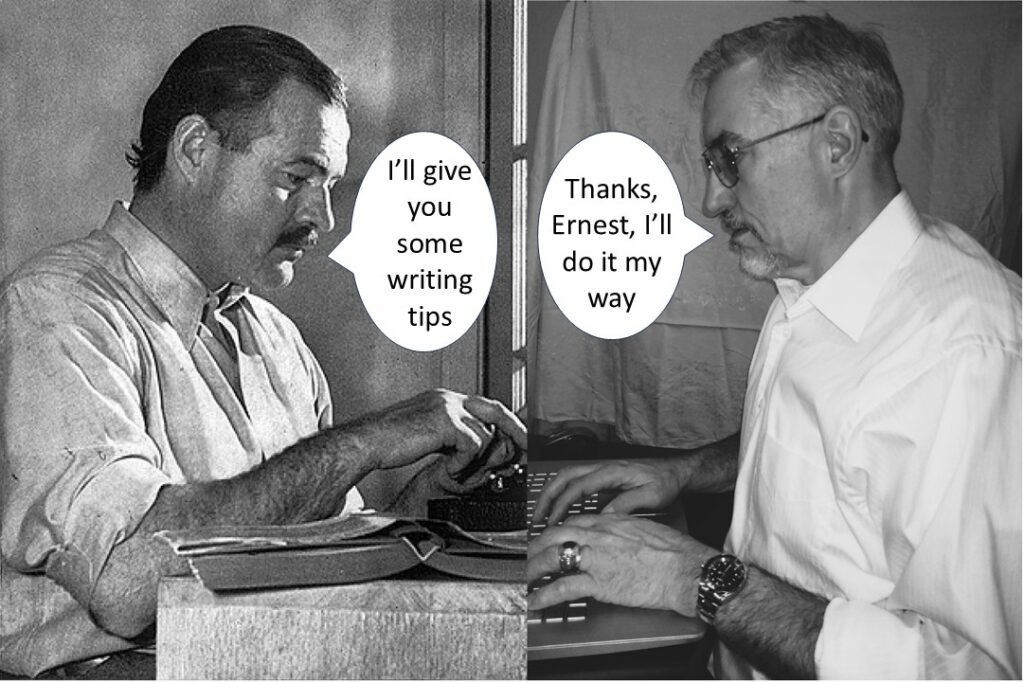Ernest Hemingway offered advice to writers and the folks at Open Culture did a wonderful job collecting and condensing his tips.

I don’t believe Hemingway intended these as eternal rules, engraved on stone tablets. Like most authors, he knew what worked for him, and also knew other writers succeeded by following their own, opposing rules. In that spirit, I’ll give my take on the seven Hemingway tips for writers.
1. To get started, write one true sentence.
To me, this sounds like a trick he used to begin a story when he felt stuck, when too many ideas floated around and he felt the need to fit everything in at once. I believe he meant to strip it all down, cut away all pretentious words, edit out the introductory phrases and get to the core of things. Hemingway called that pure, distilled essence, a “true sentence.” After writing that, he found all the other sentences flowed well.
I, too, spend a good bit of time crafting a story’s first sentence. Even after writing to the tale’s end, I go back and re-write the opening.
2. Always stop for the day while you still know what will happen next.
I agree with this. It’s difficult to call it quits when you’re in the flow, but it saves time the next day.
3. Never think about the story when you’re not writing.
To the extent I understand this, I disagree. The full paragraph version confused me. I think he found it beneficial to stop writing for the day and exhaust himself in other activities, forgetting the story until the next day, when he returned to it fresh and ready to go.
I find the opposite true for me. In restful non-writing moments, my subconscious returns to the story, then forces me to pay attention. It tells me I’ve made an error in that day’s writing, or missed an enhancing metaphor, or need to resolve a plot problem in the next day’s anticipated scene.
My subconscious finds and solves problems better than my focused mind, but can’t write on its own. When I return to writing, I’m always better off, having thought of things between sessions.
4. When it’s time to work again, always start by reading what you’ve written so far.
I concur. This sets me in the right frame of mind to pick up where I left off and to resume the flow. Most often, I find some editing of previous material is in order.
5. Don’t describe an emotion. Make it.
Solid gold advice, but I find this gold difficult to mine. Expanding on the “show, don’t tell” adage, Hemingway urges us to explore beyond explaining what a character feels. Make the reader feel it too. Crystalize the raw emotion, condense it to words, and drag the reader through it so every tender nerve ending scrapes on that feeling, so the reader’s stomach bubbles and churns with the acidity of that emotion. If I could just do that all the time, I’d be…well, like Ernest.
6. Use a pencil.
Hemingway wrote before personal computers, so this advice sounds outdated. Unlike a pen or typewriter (his only alternatives), a pencil allows self-editing in a way that makes mistakes disappear. Errors no longer clutter the page in a distracting way. Computer word processors take things a step further, always presenting your latest version, devoid of scratch-outs, in printed text as it would appear in finished form.
Even so, I most often write first drafts in pen, type them in a word processor, print and edit with pen again. It’s a personal preference. Something about the tactile sensation of writing by hand, I guess.
7. Be brief.
Well, that worked for Hemingway. Writers’ styles differ. Some authors rush readers along in an avalanche of words, and their readers enjoy the ride. Other authors force each word to pull its weight. They write as if fearing an impending word shortage, and their readers love the brevity.
With apologies to, and admiration for, Ernest Hemingway, I can’t agree with all his writing tips. Now that I think about it, perhaps that’s why he’s forever famous, and I’m just—
Poseidon’s Scribe
